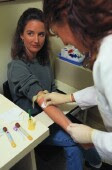Global Efforts to Lower 'Bad' Cholesterol Working
Survey of nine countries finds improvements over 10-year period.
People in the United States and around the world who are trying to lower their "bad" cholesterol have been succeeding more often in the past decade, new research suggests.
The look at almost 10,000 patients from nine countries found that, overall, 73 percent had reached their target level of low-density lipoprotein (LDL) -- nearly double the number since the survey was first conducted in 1996-1997. Three-quarters of those surveyed were on a statin drug to lower cholesterol (for an average duration of about two years), while others either used different medications or made only lifestyle changes, such as improved exercise and nutrition regimens, to try to bring down their LDL levels, the researchers found.

In the United States, patients of all levels of risk for coronary heart disease showed improvement from their initial 38 percent success rate in 1996-1997. Of those considered at low risk, 86 percent met their target LDL level; 74 percent of moderate-risk patients reached their goal; and 67 percent in the high-risk category hit their mark, according to the findings, published in the current issue of Circulation.
LDL is known as "bad" cholesterol because it is associated with increased cardiovascular risk. A person's risk category was based on factors such as having existing coronary artery disease, being obese, diabetic, a smoker and having other known links to heart disease. LDL targets were based on these risk categories, ranging from less than 160 milligrams per deciliter for those at low risk to less than 70 milligrams per deciliter for those considered very high risk, according to a news release from the American Heart Association.
The only real disappointment internationally was in the category of those considered at very high risk, where only 30 percent met their target, the study authors noted.
"Although there is room for improvement, particularly in very high-risk patients, these results indicate that lipid-lowering therapy is being applied much more successfully than it was a decade ago," study author Dr. David D. Waters, a professor emeritus of medicine at the University of California, San Francisco, said in the news release.
The rates of achieving the LDL goals ranged from 47 percent in Spain to 84 percent in South Korea, a variation the researchers were at a loss to explain. The other countries in the study, besides the United States, were Brazil, Canada, France, Mexico, the Netherlands and Taiwan.
The study was funded by Pfizer, Inc., maker of the statin drug, Lipitor.
People in the United States and around the world who are trying to lower their "bad" cholesterol have been succeeding more often in the past decade, new research suggests.
The look at almost 10,000 patients from nine countries found that, overall, 73 percent had reached their target level of low-density lipoprotein (LDL) -- nearly double the number since the survey was first conducted in 1996-1997. Three-quarters of those surveyed were on a statin drug to lower cholesterol (for an average duration of about two years), while others either used different medications or made only lifestyle changes, such as improved exercise and nutrition regimens, to try to bring down their LDL levels, the researchers found.

In the United States, patients of all levels of risk for coronary heart disease showed improvement from their initial 38 percent success rate in 1996-1997. Of those considered at low risk, 86 percent met their target LDL level; 74 percent of moderate-risk patients reached their goal; and 67 percent in the high-risk category hit their mark, according to the findings, published in the current issue of Circulation.
LDL is known as "bad" cholesterol because it is associated with increased cardiovascular risk. A person's risk category was based on factors such as having existing coronary artery disease, being obese, diabetic, a smoker and having other known links to heart disease. LDL targets were based on these risk categories, ranging from less than 160 milligrams per deciliter for those at low risk to less than 70 milligrams per deciliter for those considered very high risk, according to a news release from the American Heart Association.
The only real disappointment internationally was in the category of those considered at very high risk, where only 30 percent met their target, the study authors noted.
"Although there is room for improvement, particularly in very high-risk patients, these results indicate that lipid-lowering therapy is being applied much more successfully than it was a decade ago," study author Dr. David D. Waters, a professor emeritus of medicine at the University of California, San Francisco, said in the news release.
The rates of achieving the LDL goals ranged from 47 percent in Spain to 84 percent in South Korea, a variation the researchers were at a loss to explain. The other countries in the study, besides the United States, were Brazil, Canada, France, Mexico, the Netherlands and Taiwan.
The study was funded by Pfizer, Inc., maker of the statin drug, Lipitor.


Comments
Post a Comment